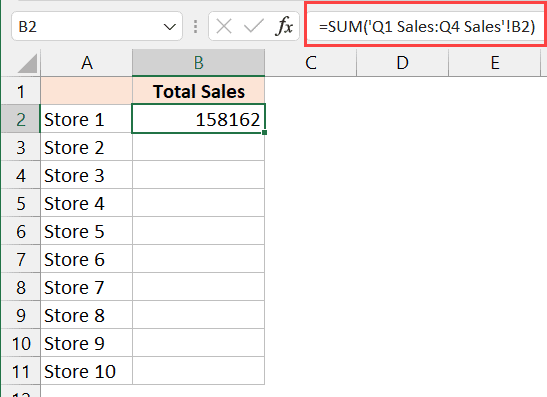3 Ways to Sum Across Sheets in Excel

Summing Across Sheets in Excel

Excel's ability to manage data across multiple sheets is not just a convenience but a necessity for modern data analysts. Whether you're working with financial reports, student grades, or any datasets that span several spreadsheets, knowing how to sum across sheets can transform your workflow. Here's how you can master this skill in three different methods, each providing a unique approach to meet diverse needs.
Using a 3D Reference Formula

The 3D reference formula in Excel allows you to sum data that shares the same cell across multiple sheets, which is incredibly useful for consistent data layout across sheets. Here’s how you can do it:
- Identify the sheets: Determine the range of sheets you want to sum. Let’s say your sheets are named "Sheet1", "Sheet2", "Sheet3", etc., up to "Sheet10".
- Set up the formula: In the cell where you want to display the total sum, enter the following formula:
=SUM(Sheet1:Sheet10!A1)
This formula sums the value in cell A1 across all sheets from "Sheet1" to "Sheet10". Excel treats this as a 3D reference, pulling data from each sheet for summation.
✍️ Note: When using a 3D formula, all sheets must have the same layout for the summation to work correctly. If a sheet is missing the specified cell, Excel will still calculate the sum with whatever sheets it can find.
Using SUM and INDIRECT Functions

The SUM and INDIRECT functions together can offer a more dynamic approach to summing data across sheets, especially when sheet names are not sequential or might change over time.
- Formula structure: The formula combines SUM with INDIRECT to navigate through sheets dynamically:
=SUM(INDIRECT("'Sheet1:Sheet10'!A1")) - How it works: INDIRECT converts a text string into a cell reference, enabling you to sum across sheets with non-standard or changing names.
Here are a few more detailed steps:
- Create a list of sheets: In a separate sheet, list the names of all sheets you want to include in the sum.
- Use the formula: If your sheet names are in cells A1:A10 of your current sheet, you can adjust the formula:
=SUM(INDIRECT("'" & A1:A10 & "'!A1"))
This formula now sums the value in A1 from all sheets listed in A1:A10 of your current sheet.
Using a Helper Column

If you're working with complex data structures where not all sheets have the same format or if you need to sum based on criteria, a helper column might be the way to go.
- Set up the helper column: In each sheet, add a column (say, column B) to hold the cell reference or value you want to sum.
- Use SUM: Then, in your summing sheet, you can simply use the SUM function across these helper columns. Here's how:
=SUM(Sheet1:Sheet10!B1)
This approach is particularly useful when:
- Sheets have different layouts or formatting.
- You need to sum based on conditions or criteria within each sheet.
- Sheets contain different data types or require pre-processing before summing.
By using a helper column, you can centralize and streamline the summing process, making it easier to adapt to changes in your data structure.
Summing across sheets in Excel not only boosts efficiency but also enhances accuracy by allowing you to quickly aggregate data from various sources. Whether you prefer the simplicity of 3D references, the flexibility of INDIRECT functions, or the customization of a helper column, mastering these techniques will elevate your spreadsheet game. Remember, each method has its strengths, so choose the one that best fits your project's complexity, data structure, and future scalability needs.
Summing up:
Across all these methods, the goal remains to provide a coherent and powerful toolset for managing data in Excel. With these approaches at your disposal, you can confidently tackle any project that involves multiple sheets, ensuring your data analysis is both effective and precise.
What is a 3D reference in Excel?

+
A 3D reference in Excel allows you to refer to the same cell or range across multiple sheets. For instance, ‘=SUM(Sheet1:Sheet3!A1)’ sums the value in cell A1 from Sheet1 through Sheet3.
Can I sum across sheets with different data layouts?

+
Yes, using a helper column or the INDIRECT function provides flexibility for sheets with different layouts. You can ensure each sheet contributes the correct data by organizing it in a helper column or dynamically referencing cells with INDIRECT.
What happens if one of the sheets is missing the cell I’m trying to sum?

+
When using 3D references or a helper column, Excel will calculate the sum with the sheets that do contain the specified cell, ignoring the sheets that don’t. With INDIRECT, you can control the sum by defining which sheets are included, but missing cells still result in the sum being calculated from the available sheets.



